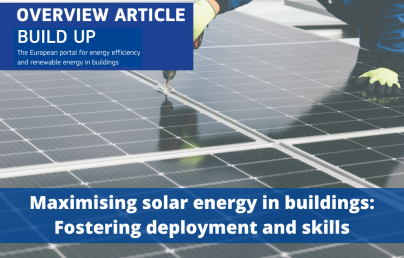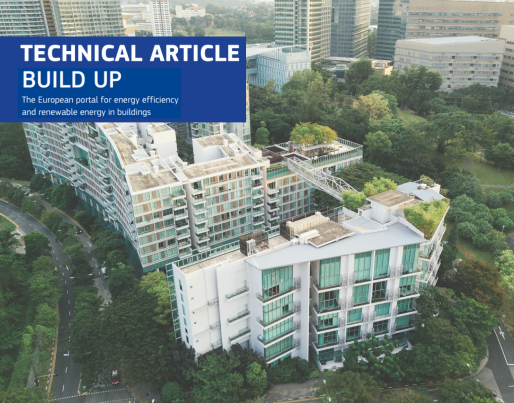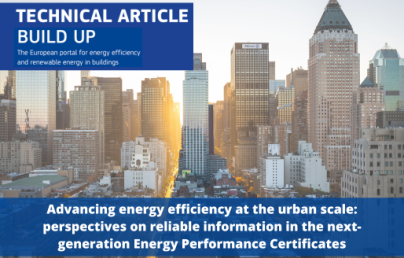
LIFE SUPERHERO project: permeable and ventilated roofs for sustainable living

LIFE SUPERHERO project: permeable and ventilated roofs for sustainable living
LIFE SUPERHERO aims to diffuse the use of ventilated and permeable roofs (VPR) and HEROTILE-based roofs (HBR) as an effective climate adaptation and mitigation solutions based on 'passive cooling'.
Benedetta Ferrari, Centro Ceramico, Joint Lab SMILE, Via Terracini 28, 40131 Bologna, Italy | LinkedIn
Maria Chiara Bignozzi, Department of Civil, Chemical, Environmental and Materials Engineering (DICAM), Bologna University, Via Umberto Terracini 28, 40131 Bologna, Italy | Personal profile
Elisa Di Giuseppe, Department of Construction, Civil Engineering and Architecture (DICEA), Marche Polytechnic University, Via Brecce Bianche 12, 60131 Ancona, Italy | LinkedIn
Alfonsina Di Fusco, Confindustria Ceramica, Viale Monte Santo 40, 41049 Sassuolo, Italy | LinkedIn
Mario Cunial, Industrie Cotto Possagno S.p.A., via Molinetto 80, 31054 Possagno, Italy | LinkedIn
(Note: opinions in the articles are of the authors only and do not necessarily reflect the opinion of the EU).
Introduction
As a consequence of climate change, during the last 15 years, the frequency and intensity of heatwaves increased in all EU, highlighting the urgent need of mitigation policies combined with appropriate actions to adapt urban systems to this new climate scenario. Observing the climate monitoring data from the Deutscher Wetterdienst Institute between 2005 and 2023 [1], the increase in mean air temperature in August is clearly visible, concentrated mainly in metropolitan areas (fig. 1).
Figure 1: Comparison of mean temperatures in Europe in August 2005 and August 2023.
Summer overheating in cities has a negative impact in terms of energy consumption for buildings cooling and consequent greenhouse gas emissions; risks to public health; reduced productivity and work efficiency; inability to use public spaces; and the reduced durability of structures and infrastructures. According to projections, the share of Europeans living in cities will be more than 80% in 2050 [2]. As a result, the Urban Heat Island (UHI) phenomenon, which leads to higher air temperatures in cities than in rural areas, will increase, as well as the energy demand for indoor cooling which is expected to triple by 2050 [3], especially in buildings with low energy performance. The resulting greenhouse gas emissions will contribute to the aggravation of the current climate emergency in a kind of 'vicious circle' that needs to be responded to with specific and effective mitigation strategies, to reduce the concentration of climate-altering gases in the atmosphere, and adaptation strategies, to make our cities and our territories resilient and prepared to face climatic events.
The role of the construction sector
The construction sector has the highest climate impact among EU sectors. Buildings are responsible for approximately 40% of energy consumption and 36% of CO2 emissions in the EU [4] and most of the building heating and cooling energy demand is still generated from fossil fuels. Currently, about 45% of the EU's buildings are built before the nineties and almost 75% of the building stock is energy inefficient, while the renovation rate of building stock is very limited. Therefore, making buildings less energy-consuming is crucial within the EU's policies and climate goals. By reducing energy consumption in buildings by at least half compared to 2005, energy efficiency measures in the building sector will contribute to the challenge against urban overheating and the achievement of a climate-neutral economy by 2050 [5].
Ventilated and permeable roofs
Overheating of residential buildings is a relevant topic especially in hot climates such as Mediterranean regions, as the energy demand for air conditioning in summer represents a significant economic and environmental cost. A good design of the building envelope and the amount of surface area directly exposed to the sun is the indispensable first step towards a comfortable and energy-efficient building. A well-known and effective strategy is the use of 'passive cooling' technologies, such as the exploitation of natural ventilation by adding a ventilated layer to facades and roofs, which reduces the temperature of the building envelope - and thus of the surrounding air - and limits the incoming heat flow.
In pitched roofs, the Above Sheathing Ventilation (ASV) can play an important role in reducing the cooling energy requirement, by increasing the natural air convection thanks to the arrangement of battens and counter-battens supporting the tiles and reducing the heat transfer due to solar radiation. The cooling potential of the ASV has been studied through both experimental [6-10] and numerical approaches [9-15]. The ASV potential could be enhanced by using discontinuous roof covering and novel tile shapes that can increase the air permeability or Under Tile Ventilation (UTV). In this way, ASV and UTV air flows are able to dissipate the excess heat gain due to solar radiation, leading to a Ventilated and Permeable Roof (fig. 2).
Figure 2: The concept of a Ventilated and Permeable Roof (VPR)
Previous studies experimentally demonstrated the better cooling performance of a VPR, also compared to other roofing typologies [16-20], such as cool or green roofs, which also require constant and expensive maintenance to ensure performance over time. The effectiveness of VPR is also derived from the results of the LIFE HEROTILE project (LIFE14 CCA/IT/000939) whose aim was to improve the design of clay tiles to increase their air permeability. The project, ended in 2019, developed new types of roof tiles, called HEROTILES (fig.3), and demonstrated the effectiveness of HEROTILE-Based Roofs (HBR) in reducing up to 50% of the energy used for air conditioning in buildings [21].

Figure 3: The HEROTILES developed during the project LIFE HEROTILE.
The effects of the improved air permeability were investigated by CFD analysis and laboratory tests and on real-scale models [22-26].
The Life Superhero strategy
Although the benefits of ventilation and air permeability of roofs are well established in the scientific literature and the LIFE HEROTILE project has achieved significant technological improvement, the cooling potential of VPR and HBR roofs is still severely limited by actual EU and national regulations, standards, green rating systems and procurements that only take into account alternative technologies including green and cool roofs. They are also still mainly focused on winter heating, consequently, VPR for climate adaptation and mitigation is still pretty unknown to common people, building stakeholders and policymakers, thus limiting its replicability and transferability. For these reasons, the LIFE SUPERHERO (SUstainability and PERformances for HEROtile-based energy efficient) project has been submitted to overcome the legislative barriers and promote the use of these new technologies for both renovation of existing buildings and for new constructions.
The five-year project, coordinated by the Centro Ceramico and started in July 2020, is funded by the LIFE Programme of the European Union under the Climate Change Adaption initiative (LIFE19 CCA/IT/001194). The structure of LIFE SUPERHERO Consortium, involving 10 partners from Italy, France and Spain, includes: roof tile manufacturers, manufacturers' associations, social housing tenants and research centres. The objective of LIFE SUPERHERO is to promote the use of VPR, and especially the improved HBR, as a sustainable and cost-effective solution for building “passive cooling”, increasing building occupants’ and cities summer comfort (adaptation) and decreasing buildings’ energy and green-house gasses emissions (mitigation).To achieve its goals, the project includes a strategy based on four parallel action pillars, as well as dissemination activities that will be carried out during and beyond the overall project duration to ensure the widest possible circulation of results among stakeholders.
The first line of action concerns the proposal of specific standards and regulations to overcome existing political barriers to the diffusion of VPR and HBR technologies. To this end, the project is developing a new test method for measuring the air permeability of roof tiles that will be included in an ETA (European Technical Assessment) document and a CEN standard. Air permeability tests are currently conducted by three European research centres (fig. 4) on 18 different types of roof tiles (including 2 types of HEROTILES) to cover almost all the different types of roof tiles available on the market: curved and flat, moulded and extruded.
Figure 4: Test equipment from Centre Technique del MatériauxNaturels de Construction (a), Marche Polytechnic University (b) and Centro Ceramico (c).
Among its recent achievements, the working group was involved in the process of revising the Minimum Environmental Criteria (CAM) and managed to include a 'ventilated roof' as a solution to 'reducing the urban heat island effect and air pollution'.
The second action focuses on the implementation of best practices for HBR roofs to demonstrate its easy and cost-effective realisation. To this end, the HBR system will be installed in 2024 on two 80’s residential buildings located in Reggio Emilia (fig. 5), characterised by a typical continental climate with very cold winters and hot summers.
Figure 5: Building pilots in Reggio Emilia.
The third action includes the development of open-source software, a support tool for consultants, planners and public administrations to evaluate the environmental (LCA) and economic (LCC) life cycle benefits of VPR/HBR. The last action aims to demonstrate the easy and cost-effective transferability of the HBR roof concept also from an industrial point of view; to this end, technology transfer activities and good manufacturing practices are underway that will ensure the conversion of traditional roof tile production processes into innovative ones for HEROTILES.
LIFE SUPERHERO generated significant interest that culminated in the participation, in November 2022, in the side event 'Climate is LIFE: Italian project solutions for fighting climate change', organised in Sharm El Sheikh by Italy's LIFE National Contact Point (NCP), during the XXVII Conference of the Parties to the United Nations Convention on Climate Change (UNFCCC COP27). The project, which already has a dedicated website and a LinkedIn profile, was presented in several highly relevant contexts for the construction sector including trade fairs (SAIE, CERSAIE, Klimahouse, CONSTRUTEC), conferences (TBE Congress, ECERS), events (Qualicer, Ecomondo) workshops (in Bologna, Madrid) and technical meetings (CEN TC 128 SC3).
Conclusion
The LIFE SUPERHERO project is essential to demonstrate that a ventilated roof equipped with the innovative HEROTILES clay roof tiles is an alternative, effective, sustainable and low-cost roofing technology for climate change adaptation and mitigation. The monitoring of demonstration buildings, tests by several laboratories on different types of roofing, updated technical documents/standards and dedicated software will ensure sufficient market penetration and effective environmental impact. This impact will result in lower external and internal surface temperatures of the roofs, leading to improved indoor comfort, reduced energy demand for cooling and lower related greenhouse gas emissions.
References
[1] Germany’s National Meteorological Service, Deutscher Wetterdienst, (n.d.).
https://www.dwd.de/EN/climate_environment/climatemonitoring/climatemonitoring_node.html
[2] European Environment Agency. The European environment – state and outlook 2020. https://www.eea.europa.eu/soer/publications/soer-2020
[3] International Energy Agency (2018) The Future of Cooling
[4] European Commission. Energy efficiency in buildings.
[5] European Commission, RACCOMANDAZIONE (UE) 2019/786 DELLA COMMISSIONE dell’8 maggio
2019 sulla ristrutturazione degli edifici, 6 (2019) 34–79.
[6] Dimoudi A, Androutsopoulos A, Lykoudis S (2006) Summer performance of a ventilated roof component. Energy Build 38:610–617. https://doi.org/10.1016/j.enbuild.2005.09.006
[7] Janssens a, Hens H (2007) Effects of wind on the transmission heat loss in duo-pitched insulated roofs: A field study. Energy Build 39:1047–1054. https://doi.org/10.1016/j.enbuild.2006.10.016
[8] Lee S, Park SH, Yeo MS, Kim KW (2009) An experimental study on airflow in the cavity of a ventilated roof. Build Environ 44:1431–1439. https://doi.org/10.1016/j.buildenv.2008.09.009
[9] Roels S, Deurinck M (2011) The effect of a reflective underlay on the global thermal behaviour of pitched roofs. Build Environ 46:134–143. https://doi.org/10.1016/j.buildenv.2010.07.005
[10] Tong S, Li H (2014) An efficient model development and experimental study for the heat transfer in naturally ventilated inclined roofs. Build Environ 81:296–308. https://doi.org/10.1016/j.buildenv.2014.07.009
[11] Ciampi M, Leccese F, Tuoni G (2005) Energy analysis of ventilated and microventilated roofs. Sol Energy 79:183–192. https://doi.org/10.1016/j.solener.2004.08.014
[12] Miller W, Keyhani M, Stovall T, Youngquist A (2008) Natural convection heat transfer in roofs with above-sheathing ventilation. In: Thermal Performance of the Exterior Envelopes of Whole Buildings. ASHRAE
[13] Miller W, Keyhani M, Stovall T, Youngquist A (2008) Natural convection heat transfer in roofs with above-sheathing ventilation. In: Thermal Performance of the Exterior Envelopes of Whole Buildings. ASHRAE
[14] Villi G, Pasut W, de Carli M (2009) CFD modelling and thermal performance analysis of a wooden ventilated roof structure. Build Simul 2:215–228. https://doi.org/10.1007/s12273-009-9414-7
[15] Gagliano A, Patania F, Nocera F, et al (2012) Thermal performance of ventilated roofs during summer period. Energy Build 49:611–618. https://doi.org/10.1016/j.enbuild.2012.03.007
[16] D’Orazio M, Di Perna C, Di Giuseppe E (2010) The effects of roof covering on the thermal performance of highly insulated roofs in Mediterranean climates. Energy Build 42:1619–1627. https://doi.org/10.1016/j.enbuild.2010.04.004
[17] D’Orazio M, Stazi A, Di Perna C, Di Giuseppe E (2011) The physics of vented roofs in hot and temperate climates: Analysis of different strategies for the reduction of energy consumption and the improvement of environmental comfort. In: Energy and Buildings: Efficiency, Air Quality and Conservation. pp 349–368
[18] D’Orazio M, Di Perna C, Di Giuseppe E, Morodo M (2013) Thermal performance of an insulated roof with reflective insulation: Field tests under hot climatic conditions. J Build Phys 36:229–246. https://doi.org/10.1177/1744259112448181
[19] D’Orazio M, Di Giuseppe E, Cozzolino N, et al (2019) “Equivalent” reflectance of tiled pitched roofs. Assessment of benefits for cooling buildings and Urban Heat Island. Laterservice Edizioni
[20] Di Giuseppe E, Sabbatini S, Cozzolino N, et al (2019) Optical properties of traditional clay tiles for ventilated roofs and implication on roof thermal performance. J Build Phys 42:484–505. https://doi.org/10.1177/1744259118772265
[21] LIFE HEROTILE - High Energy savings in building cooling by ROof TILEs shape optimization toward a better above sheathing ventilation. http://www.lifeherotile.eu/ Accessed 29March 2024
[22] Bortoloni M, Bottarelli M, Piva S (2017) Summer Thermal Performance of Ventilated Roofs with Tiled Coverings. J Phys Conf Ser 796:012023. https://doi.org/10.1088/1742-6596/796/1/012023
[23] Bottarelli M, Zannoni G, Bortoloni M, et al (2017) CFD analysis and experimental comparison of novel roof tile shapes. Propuls Power Res 6:134–139. https://doi.org/10.1016/j.jppr.2017.05.006
[24] Bottarelli M, Bortoloni M, Zannoni G, et al (2017) CFD analysis of roof tile coverings. Energy 137:391–398. https://doi.org/10.1016/j.energy.2017.03.081
[25] Bottarelli M, Bortoloni M (2017) On the heat transfer through roof tile coverings. Int J Heat Technol 35:S316–S321. https://doi.org/10.18280/ijht.35Sp0143
[26] Bottarelli M, Bortoloni M, Dino G (2018) Experimental analysis of an innovative tile covering for ventilated pitched roofs. Int J Low-Carbon Technol 13:6–14. https://doi.org/10.1093/ijlct/ctx014

